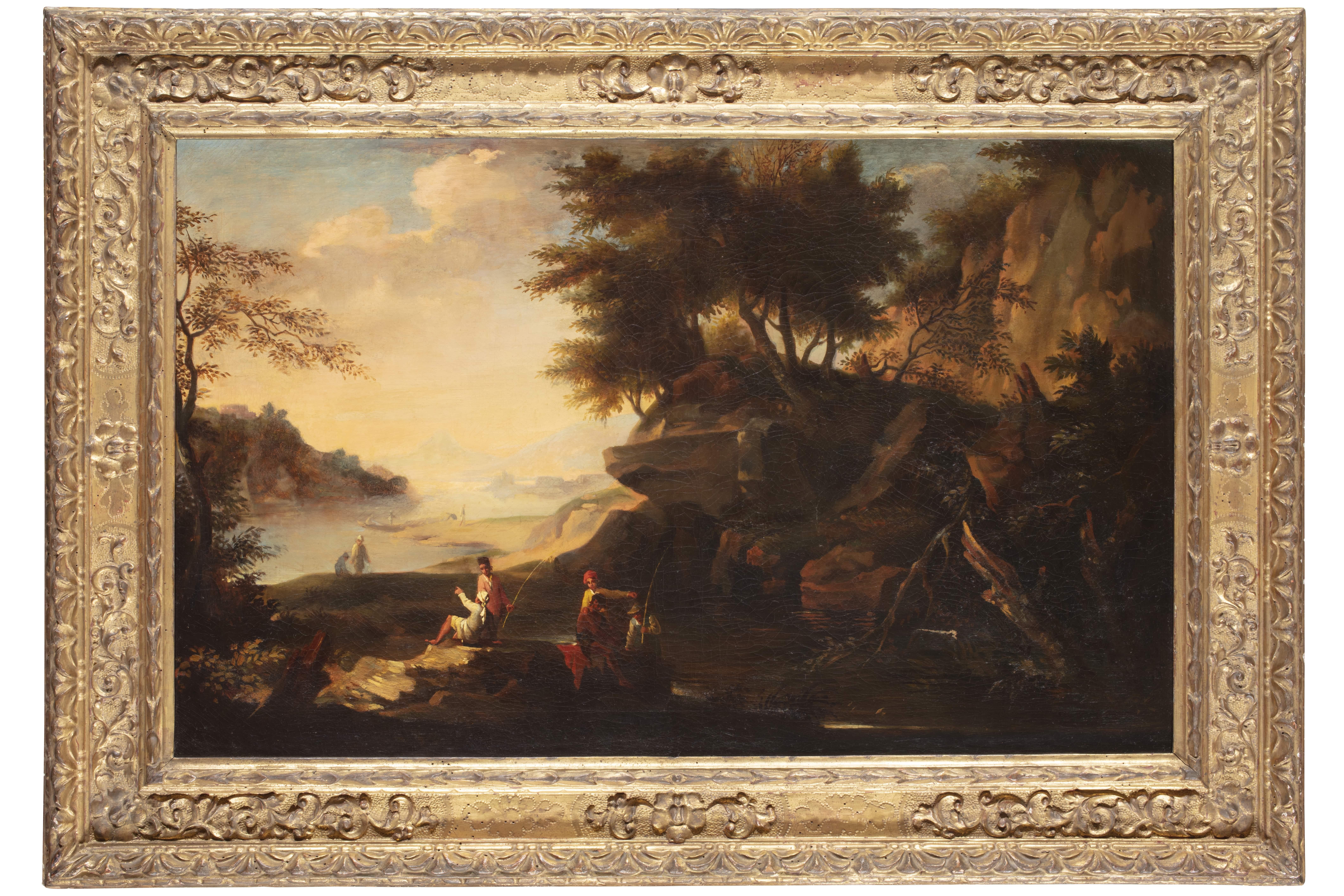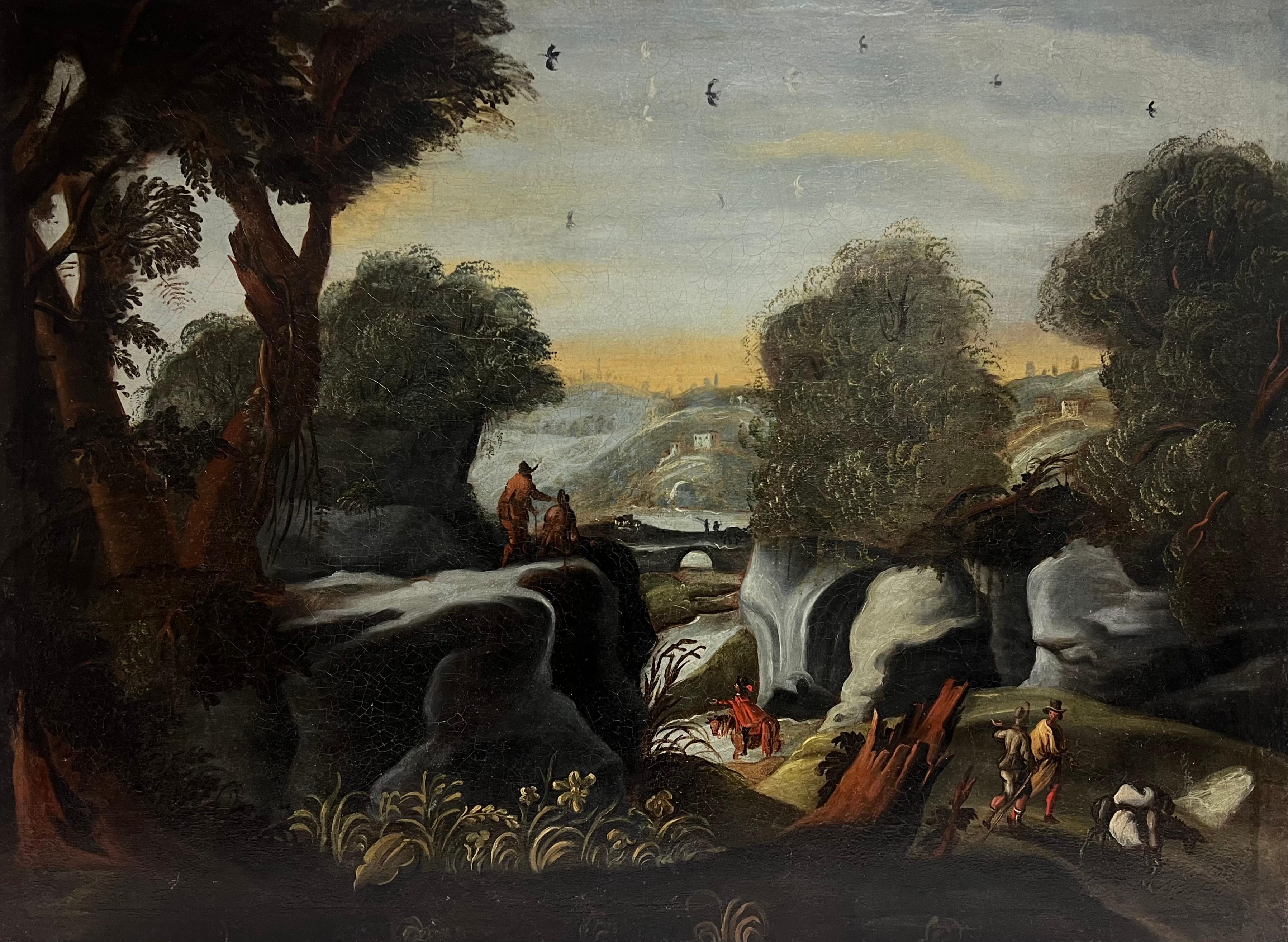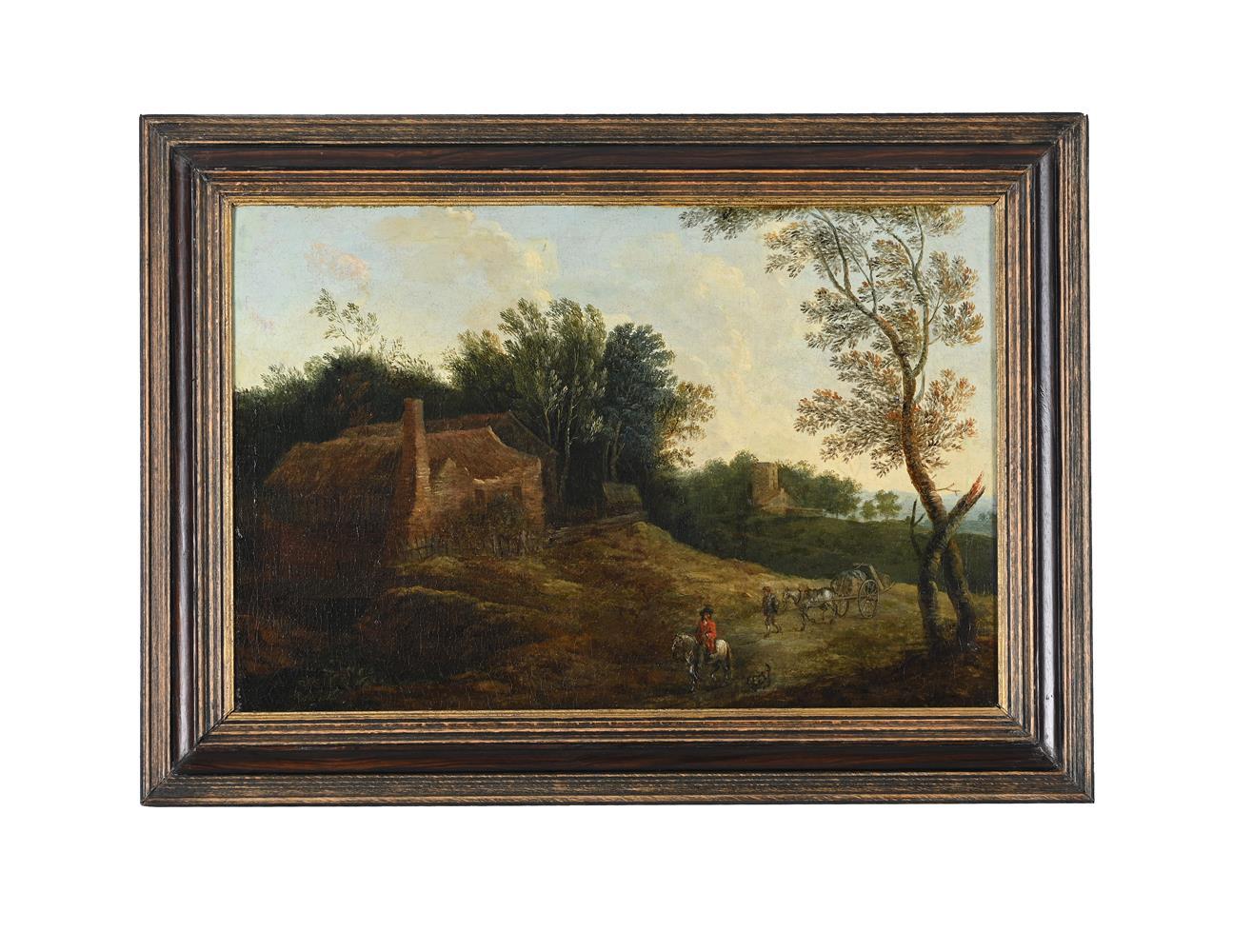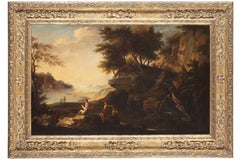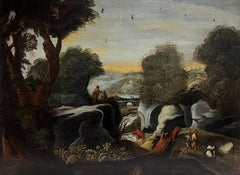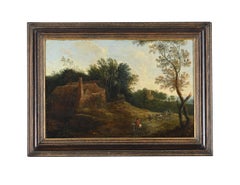Items Similar to Wooded Figurative River Landscape - Dutch 17thC Golden Age art oil painting
Want more images or videos?
Request additional images or videos from the seller
1 of 17
Abraham Jansz BegeynWooded Figurative River Landscape - Dutch 17thC Golden Age art oil paintingCirca 1640
Circa 1640
$9,402.78
$11,753.4820% Off
£6,800
£8,50020% Off
€8,011.23
€10,014.0320% Off
CA$13,028.03
CA$16,285.0320% Off
A$14,137.39
A$17,671.7420% Off
CHF 7,491.57
CHF 9,364.4720% Off
MX$173,388.25
MX$216,735.3120% Off
NOK 92,707.67
NOK 115,884.5920% Off
SEK 87,603.84
SEK 109,504.8020% Off
DKK 59,807.81
DKK 74,759.7620% Off
About the Item
This superb 17th century Dutch Golden Age oil painting has been more recently reattributed to Abraham Begeyn by Dr Marijke C. de Kinkelder formerly of the RKD - Netherlands Institute for Art History. Painted circa 1640 it is an Italianate wooded river landscape with drovers and their herd crossing a river with a watchtower beyond. Begeyn was one of the many 17th-century Dutch and Flemish painters to embrace the Italianate style, populating their decidedly non-Dutch, mountainous landscapes with rustic travellers and picturesque ruins bathed in warm, Mediterranean light. It has Begeyn's characteristic brightly lit cattle and grouping of figures, similar to a comparable painting in the Lichtenstein Princely Collections. The brushwork and details are superb. One can see the influence of his teacher Nicholaes Berchem (1620-1683) and the typical golden glow of the Golden Age painters. This is a stunning 17th century Golden Age oil painting and an excellent example of Begeyn's work.
Provenance: With Koetser Gallery, Zurich. Private Collection (Rhine region). Anon. sale, Dorotheum, Vienna, 22 June 2010, lot 357, as by Jacob de Heusch (€18,600).
Anon. sale, Christie's South Kensington,18 November 2015, lot 432, as 'Follower of Nicolaes Berchem'; where purchased by the present owner.
Note: Begeyn was one of the many 17th-century Dutch and Flemish painters to embrace the Italianate style, populating their decidedly non-Dutch, mountainous landscapes with rustic travellers and picturesque ruins bathed in warm, Mediterranean light.
He is thought to have studied under Nicolaes Berchem (1620-1683), a pioneer of this genre of landscape painting, and travelled extensively to Italy, London and later to Germany in 1688, where he lived out his days as court painter to Frederick III, Elector of Brandenburg (later Frederick I, King of Prussia).
The present work was previously thought to be the work of Jacob de Heusch (1656-1701), but has been more recently reattributed to Abraham Begeyn by Dr Marijke C. de Kinkelder formerly of the RKD - Netherlands Institute for Art History.
A comparable scene, which also includes Begeyn's characteristic brightly lit cattle and a similar figure group, was sold at Christie's Amsterdam, 18 November 2015, lot 110. Another can be found in the Liechtenstein Princely Collections (no.GE 290).
Condition. Oil on canvas, image size 21 inches by 18 inches and in good condition.
Frame. Housed in a beautiful gilt frame, 28 inches by 25 inches and in good condition.
Abraham Begeyn (c. 1637 Leiden - 11 June 1697 Berlin), was a Dutch Golden Age painter. Begeyn was born in Leiden. Though perhaps known mostly for his Italianate landscapes and cattle in the manner of Nicolaes Pietersz Berchem, Begyn was a highly skilled painter active in many genres, who travelled widely. According to the RKD, Begeyn's earliest known work is from 1653, though he was first accepted into the Guild of St. Luke in Leiden in 1655. He stopped paying dues in 1667, because he set off for a trip to Italy. He is registered in Rome and Naples from 1659–1660. In the rampjaar or disaster year, of 1672, he is registered in Amsterdam, and after that he lived in London, where he painted at Ham House, Surrey, together with Willem van de Velde the Younger (1633–1707) and Dirck van Bergen (1645–1690). In 1681 he was in the Hague where two years later he became a member of the painters' confraternity 'Pictura'. He moved to Berlin in 1688, where he became Prussian court painter. There his works were greatly prized, and, according to Houbraken, he was principal painter to Frederick III, the elector of Brandenburg, afterwards king of Prussia. He died of a heart attack when Augustinus Terwesten came to visit his studio, accompanied by two other painters. It is highly possible that he felt put under great pressure by Terwesten to perform, since Terwesten had also become court painter in Berlin and had also started an academy there, which opened in 1697. Begeyn died in Berlin. In many collections in the Netherlands, the pictures of Begeyn are placed amongst those of the most admired masters. His pencilling is light and free, and his colouring very agreeable. Many of his works are landscapes like Peasants with Cattle by a Ruin, with views of rivers, ruins, and pieces of architecture, enriched with figures and a variety of animals. He is also known for his still life paintings of flowers and hunting paraphernalia.
- Creator:Abraham Jansz Begeyn
- Creation Year:Circa 1640
- Dimensions:Height: 28 in (71.12 cm)Width: 25 in (63.5 cm)Depth: 2 in (5.08 cm)
- Medium:
- Movement & Style:
- Period:1640-1649
- Condition:
- Gallery Location:Hagley, GB
- Reference Number:1stDibs: LU853114375142
About the Seller
5.0
Platinum Seller
Premium sellers with a 4.7+ rating and 24-hour response times
1stDibs seller since 2018
463 sales on 1stDibs
Typical response time: 1 hour
- ShippingRetrieving quote...Shipping from: Hagley, United Kingdom
- Return Policy
Authenticity Guarantee
In the unlikely event there’s an issue with an item’s authenticity, contact us within 1 year for a full refund. DetailsMoney-Back Guarantee
If your item is not as described, is damaged in transit, or does not arrive, contact us within 7 days for a full refund. Details24-Hour Cancellation
You have a 24-hour grace period in which to reconsider your purchase, with no questions asked.Vetted Professional Sellers
Our world-class sellers must adhere to strict standards for service and quality, maintaining the integrity of our listings.Price-Match Guarantee
If you find that a seller listed the same item for a lower price elsewhere, we’ll match it.Trusted Global Delivery
Our best-in-class carrier network provides specialized shipping options worldwide, including custom delivery.More From This Seller
View AllTravellers in Wooded Landscape - Dutch 17th century art Old Master oil painting
By Jan Wijnants (circle)
Located in Hagley, England
An original, very large Dutch Old Master oil on canvas which is attributed to circle of Jan Wijnants and was painted circa 1680. The huge canvas is in good clean condition and depicts a wooded landscape with travellers passing through. A delightful very large country house old master painting.
Provenance. Private collection, Christies.
Condition. Oil on canvas. Very large, image size is 53 inches by 41 inches and in good clean condition.
Framed size is 63 by 51 inches. The carved original 17th Century wood frame...
Category
17th Century Old Masters Landscape Paintings
Materials
Oil
Italian Landscape with Travellers - Dutch Golden Age 17thC art oil painting
Located in Hagley, England
This superb Dutch Golden Age Old Master landscape oil painting is attributed to Jacob van der Croos. Painted circa 1670 it is an Italianate landscape with figures and their animals i...
Category
17th Century Old Masters Landscape Paintings
Materials
Oil
$17,699 Sale Price
20% Off
Travellers near Ruins in a Landscape - Dutch Old Master art figural oil painting
By Pieter Wouwerman
Located in Hagley, England
This lovely Dutch Old Master oil painting is attributed to artist Pieter Wouwerman. Painted circa 1660 it is figurative landscape with horseback travellers and their dogs in the foreground approaching ruins on their left. Beyond is a river snakes through the landscape, beneath the fading light of approaching dusk. There are some superb details making this an excellent Dutch Golden Age oil painting...
Category
Mid-17th Century Old Masters Landscape Paintings
Materials
Oil
Villagers in a Landscape - Flemish 17thC art figurative landscape oil painting
Located in Hagley, England
This fantastic Flemish 17th century Old Master oil painting is by Thomas Van Apshoven. It was painted circa 1650 and depicts a village with figures outside a tavern, eating, drinking and dancing. Beyond are more dwellings, villagers and animals, all under a blue summer's sky. The detail, brushwork and vibrant colouring are superb. This is an excellent example of Apshoven's work and a typical subject he loved to paint.
Provenance. Leominster estate.
Wax stamp verso.
Condition. Oil on panel, 22 inches by 17 inches and in good condition.
Frame. Housed In beautiful gilt frame, 30 inches by 25 inches and in good condition.
Thomas van Apshoven (1622– 1664) was a Flemish painter known for his landscapes with peasant scenes and genre scenes in interiors. His genre scenes depict village festivals, the interiors of taverns, village scenes or landscapes with peasants engaged in various activities, singeries, guardroom scenes and laboratories of alchemists. Some still lifes have also been attributed to him. His themes and style are close to that of David Teniers the Younger. He was born on 30 November 1622 in Antwerp as the eldest son of Ferdinand van Apshoven the Elder and Leonora Wijns. His father was a painter who had studied with Adam van Noort and had become a master of the Antwerp Guild of Saint Luke in 1596. No paintings by his father are known. His younger brother Ferdinand van Apshoven the Younger became also a successful painter. Thomas studied under his father. Some sources state that he became a pupil of the prominent genre painter David Teniers the Younger. It is more likely, however, that he was an imitator of Teniers. He was registered as a 'wijnmeester' [son of a master] in the Guild of St. Luke of Antwerp in the guild year 1645–1646. He married Barbara Janssens on 22 March 1645. The couple had four children. The godfathers of the children included the painters Victor Wolfvoet...
Category
1650s Old Masters Figurative Paintings
Materials
Oil
Italian Landscape - Dutch Old Master art Grand Tour landscape oil painting
Located in Hagley, England
This simply stunning large Old Master landscape oil painting is attributed to noted Dutch artist Adriaen van Diest. Painted circa 1700 this Mediterranean Italian landscape painting has everything; A really interesting landscape with land, river, sea and mountains, interesting figures and cattle and a wonderful sky with fading light. The details and the capturing of the light make this a really fantastic Dutch Old Master country house Grand Tour oil painting. Irresistible.
Provenance. Dorset estate.
Condition. Oil on canvas, 42 inches by 20 inches and in good condition.
Frame. Housed in an English carved giltwood frame, 50 inches by 28 inches framed and in good condition.
Adriaen van Diest (1655-1704) was born in the Hague in the Netherlands. Like his father and his brother, he pursued a career as a marine painter, that is, a painter of seascapes and sailing ships. In 1673, attracted by the thriving English market for portraits and marine paintings, he joined the exodus of Dutch artists leaving to work in England. It is thought that his master was Willem van de Velde the Younger...
Category
Early 1700s Old Masters Landscape Paintings
Materials
Oil
$21,569 Sale Price
20% Off
Old Master Wooded Landscape - Irish 1830 art woodland oil painting
By James Arthur O'Connor
Located in Hagley, England
A delightful large oil on canvas of a wooded landscape which dates to circa 1830 and is attributed to Irish artist James Arthur O’Connor. A superb painting and an excellent example o...
Category
18th Century Old Masters Landscape Paintings
Materials
Oil
$44,248 Sale Price
20% Off
You May Also Like
17th Century by Jacob de Heusch Pair of Landscapes Oil on Canvas
Located in Milano, Lombardia
Jacob De Heusch (Utrecht, Netherlands, 1657 – Amsterdam, Netherlands, 1701)
Title: Pair of Landscapes
Medium: Oil on canvas
Dimensions: without frame 50 x 8...
Category
17th Century Old Masters Landscape Paintings
Materials
Oil, Canvas
Huge 18th Century Flemish Classical Oil Painting Travellers River Landscape
Located in Cirencester, Gloucestershire
Travellers in Landscape
Flemish Old Master, 18th century
oil on on canvas, unframed
canvas : 29 x 39 inches
Provenance: private collection, France
Condition: very good condition
For...
Category
18th Century Old Masters Figurative Paintings
Materials
Oil
Fine 17th Century Flemish Old Master Oil Painting Travellers Country Landscape
Located in Cirencester, Gloucestershire
Travellers in a Country Landscape
circle of Jacques d'Arthois (Flemish 1613-1686)
oil on canvas, framed
frame: 13.5 x 18.5 inches
canvas: 11 x 16 inches
provenance: private collectio...
Category
17th Century Old Masters Landscape Paintings
Materials
Oil
River Landscape Water Michout 17/18th Century Paint Oil on canvas Old master
Located in Riva del Garda, IT
Théobald Michou (Tournai, 1676 – Antwerp, 1765)
River landscape with village
Oil on canvas 62 x 98 Framed 74 x 110 cm
We present this vast and harmonious composition, where ...
Category
17th Century Old Masters Paintings
Materials
Oil
$7,345 Sale Price
20% Off
17th Century by Pieter Mulier Landscape Oil on Canvas
By Pieter Mulier known as the Cavalier Tempesta (Haarlem 1637 - Milan 1701)
Located in Milano, Lombardia
Pieter Mulier known as Tempesta (Haarlem, Netherland, 1637 - Milan, Italy, 1701)
Title: Landscape
Medium: Oil on canvas
Dimensions: without frame 49 x 65...
Category
17th Century Old Masters Landscape Paintings
Materials
Canvas, Oil, Cotton Canvas
Landscape with Stream - Oil on Canvas - 18th Century
Located in Roma, IT
Original Oil on Canvas, probably of Dutch School, of the mid-18th Century. Wood Lable attributing the work to E. Williams Senior.
Small restoration, otherwise very good condition.
Category
18th Century Modern Figurative Paintings
Materials
Canvas, Oil
More Ways To Browse
Dior Heart
Dutch Master Oil Painting Flowers
Frederick Of Prussia
Dutch Oil Painting River
Willem Van De Velde
Sail Boat Painting
Swedish Impressionist
Tennessee Painting
American Painting Gold Frame
American Regionalism Art
Austin Hill
Australian Oil Painting
City Skyline Art
Hawaiian Oil Paintings
Ile De La Cite
Lake Boat Painting
Maggy Clarysse
Midwest Landscape
